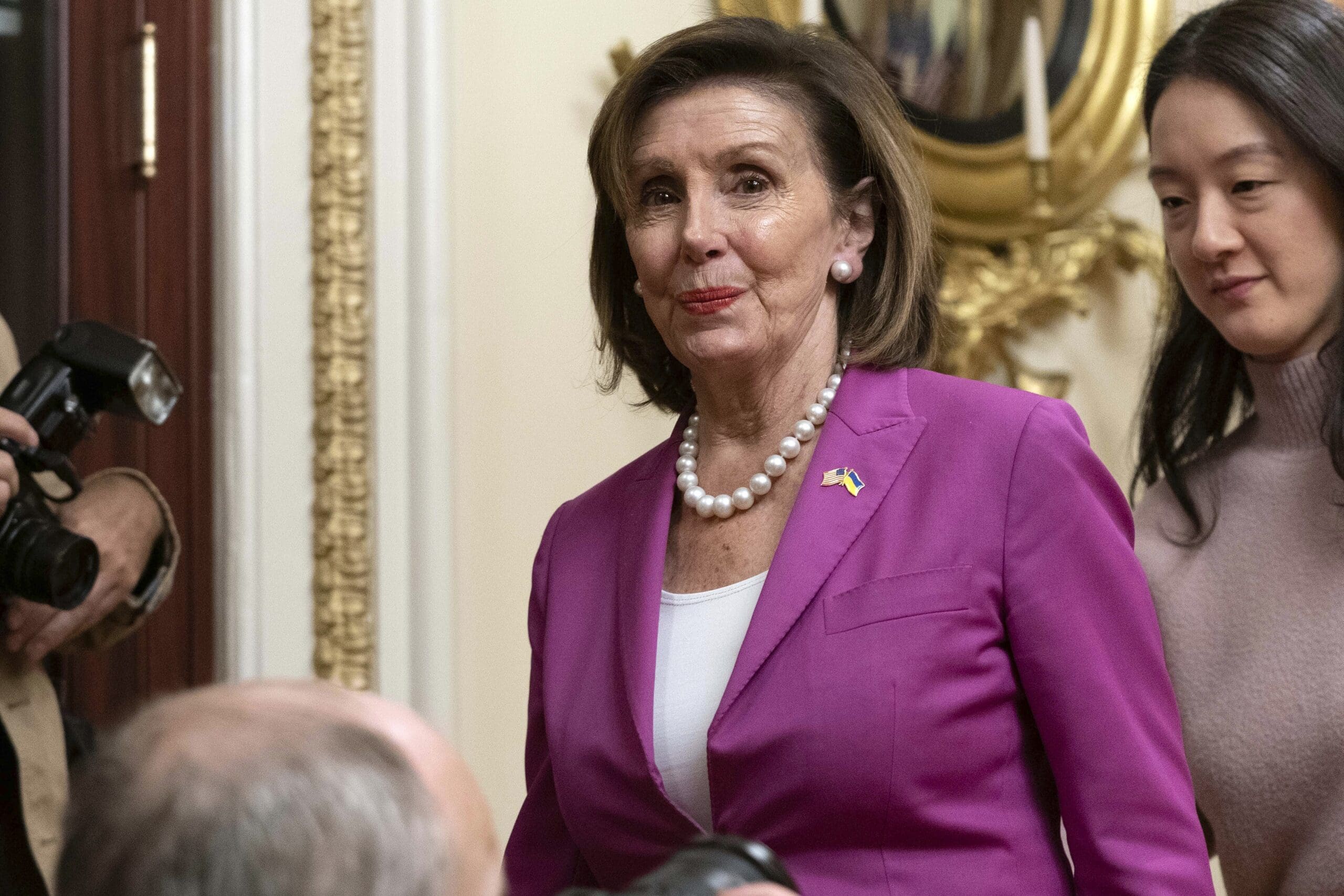
Pelosi’s 5 Rules for Reigning Over Congress

If leading a House caucus was easy, then everyone who ever did it would serve for two decades, claim the speaker’s gavel twice, withstand merciless mockery and shepherd several landmark bills to the Oval Office. But Nancy Pelosi practically stands alone. Only Sam Rayburn’s tenure eclipses hers in length, and he didn’t have to suffer years of brutal television ads attacking him as a San Francisco radical.
Democrats who have been dependent on her steely demeanor and impossibly precise vote counts may feel unsteady, even those younger lawmakers frustrated at how long she clung to power. Pelosi’s apparent successor, Rep. Hakeem Jeffries of New York, will immediately face pressure to maintain party unity in a narrowly divided House.
Can Jeffries — or anyone — replicate Pelosi’s accomplishments and legacy? Fortunately, for those paying close attention, the outgoing speaker offered a 20-year master class of legislative leadership.
Here are five big lessons Pelosi taught us about how change is really made in Washington.
1. When Counting the Votes, Get It in Writing
Vote counting is more complicated than it looks for one simple reason: People lie. As recounted by biographer Molly Ball, Pelosi learned that lesson the hard way early in her career. A House colleague told Pelosi he would support her bid for a seat on the Appropriations Committee, and so she counted him as a yes vote. But he ended up voting for someone else. When she confronted him, he explained, “I was for you without knowing who else was running. Once I found out who else was running, I wasn’t for you anymore.”
Going forward, Ball wrote, “Pelosi learned to listen to what people were saying, not what she wanted to hear — and to get it in writing if possible.” (And on top of that, “best to get some extra commitments for insurance.”)
2. Beware “The City of the Perishable”
Pelosi summed up her tactical philosophy with a tautological maxim: “You get the votes and you take the vote.” For emphasis, she would make a fist to represent getting the votes, and punch her other hand to represent taking the vote.
Her underlying point was a party leader can’t dally once the votes are in hand. “I call Washington ‘the city of the perishable’ she also said, “because you never know what can happen.”
This is advice Pelosi herself struggled to heed last year. The Senate handed her a bipartisan infrastructure bill, but House progressives balked at passing it before a multi-faceted Build Back Better package. With negotiations ongoing and some moderates yet to commit to Build Back Better, progressives hoped that holding out on infrastructure would extract the necessary support. The battle for leverage soon escalated when a small band of House moderates demanded the infrastructure bill clear Congress immediately.
The squabbling put Pelosi’s principles in conflict. She liked to go big. (During the protracted Affordable Care Act legislative process, she scoffed at the idea from White House Chief of Staff Rahm Emanuel for a smaller bill, dubbing it “Kiddie Care.”) And she didn’t like proceeding without the votes firmly in hand. But she also knew bills can perish.
In the summer of 2021, Pelosi initially sided with the progressive holdouts and delayed action on infrastructure. But she changed tack in September, and pushed for a stand-alone infrastructure vote, on the grounds that Senate negotiations on Build Back Better were taking longer than expected. The House then passed the infrastructure bill after Democrats lost the Virginia governorship in the November 2021 election.
Still, Democratic leaders could not get Sen. Joe Manchin to accept Build Back Better. Then in the summer of 2022, when Manchin and Senate Majority Leader Chuck Schumer struck a deal on a smaller package of climate, health care and tax initiatives, Pelosi was able to return to her tactical principle. Less than a week after the bill passed the Senate, Pelosi rammed it through the House.
3. Fight for Progressive Goals… So You Can Sacrifice Them Later
Counting votes is great, if the votes are there. But sometimes they’re not. And Pelosi long recognized that House progressives could not be presumed to accept whatever compromises the Senate and its stubborn filibuster rules can produce. Often, deflated progressives would have to be persuaded. Pelosi deduced that the best way to rally progressives behind legislation they consider insufficient is to show that before accepting any deal, she fought as hard as possible on behalf of their shared, aspirational agenda.
Pelosi executed such a strategy when Barack Obama was pushing Congress to pass health care reform. In September 2009 she made what sounded like an ultimatum: “A bill without a strong public option will not pass the House.” The House passed a bill two months later that included a public option for health insurance. When the Senate didn’t reciprocate, Pelosi had the credibility to break the bad news without losing votes. “I’m quite sad that the public option is not in there,” Pelosi told her caucus, “It isn’t in there because they don’t have the votes.” She kept progressives on board to win a 219-212 vote.
Pelosi deployed the same tactics in 2021 with the infrastructure bill and Build Back Better package, as mentioned above. She allied with the left and supported a linkage between the two measures, until that was no longer tenable and then treated the two bills separately.
4. Don’t Take it Personally
The leader of a diverse coalition inevitably struggles to satisfy members from different ends of the ideological spectrum. Pelosi recognized that being identified with progressives harmed her reputation with moderates, but she also knew she needed moderates to win swing districts so Democrats could win a majority and she could wield the gavel.
If that meant moderate Democratic lawmakers voted against party priorities, that was acceptable, so long as Pelosi could still enact her agenda. Thirty-four House Democrats bailed on the Affordable Care Act, but she still passed it with a few votes to spare.
And if that meant moderate Democratic candidates had to join their Republican opponents in attacking her on the campaign trail, so be it.
During the 2018 midterm elections, when Republicans were featuring Pelosi in about 20 percent of their ads, 48 Democratic challengers (most of whom did not eventually win) sought to distance themselves from Pelosi by conveying opposition to her continued House leadership role.
Pelosi didn’t punish them by cutting off campaign funds. She still wanted them to win so Democrats could have the majority. And she knew that most of those candidates did not pledge to vote against her in a final vote for speaker on the House floor; they could satisfy their pledges with softer moves — opposing her nomination in the Democratic caucus vote, or by voting “present” on the House Floor. (In the end, Pelosi won the speakership with 220 votes; 12 Democratic members voted for someone else, with another three voting “present.”) She understood these candidates were doing what they felt they needed to do to win and didn’t let it break her stride.
5. Don’t Be Obstructionist
Pelosi expected very little of Republicans and sometimes charged fellow Democrats with naivete if they held their hopes up too high about the prospect of bipartisan compromise. Ball wrote that Pelosi was frustrated with the Obama administration for chasing Republican votes during the Affordable Care Act deliberations, and predicted, accurately, that no Republicans would cross the aisle. “Does the president not understand the way this game works?” she vented to Obama’s chief of staff. “He wants to get it done and be beloved, and you can’t have both.”
Yet Pelosi still found ways to work with Republicans and refused to obstruct just for the sake of obstruction. Months after becoming speaker for the first time in 2007, when Democratic opposition to the Iraq War was fervent, Pelosi declined to block a bill to fund the war. Instead, she saw an opportunity to make a deal, and attached an unrelated, 40 percent increase in the federal minimum wage, which President George W. Bush signed. She also cooperated with Donald Trump to keep the government open, avoid a debt default, pass criminal justice reform and distribute pandemic relief.
For much of her 20-year reign, Pelosi was treated like a burden. She was never a great orator or extemporaneous talker. She was not only a San Francisco liberal, but an insanely wealthy San Francisco liberal, the antithesis of the working-class voter Democrats struggled to reach.
But Pelosi knew that her value, and the value of any legislative leader, is not determined by superficial image. She let the party’s presidential candidates worry about being charismatic and stuck to mastering the job at hand: getting the votes and taking the votes.
During her time in public life, no one did it better. That’s why she stayed in her post as long as she did, and that’s why she went out at the top of her game. Any budding legislator or leader, Democrat or Republican, should learn from the master.







